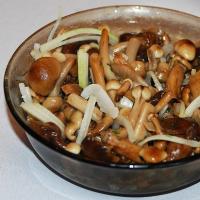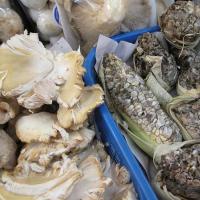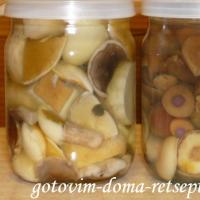Pale grebe: photo, description of the mushroom and signs of poisoning
Few people know that the toadstool mushroom (Amanita phalloides) is a fly agaric in the full sense of the word. Even its second name - green fly agaric - speaks for itself.
In this article we will tell you what to do if you are poisoned by toadstool, where this mushroom grows and what it looks like.
The description of the pale toadstool is very similar to the greenish russula and even champignon.
The cap of one of the most poisonous mushrooms in the world (diameter 6-16 cm): light olive, can be intensely green, gray, yellowish or almost white, covered with a thin film.
Changes size and shape depending on the age of the mushroom.
Pay attention to the photo of the pale toadstool: its cap in shape and size resembles a small chicken egg:

Over time, the upper part grows and changes from hemispherical to almost flat with smooth edges.

Leg (height 9-17 cm): cylindrical, tapering from bottom to top. The color is usually the same as the cap.

The plates are frequent, soft, white. The pulp does not emit any odor and does not change white color at the cut site.
Where and when does the toadstool grow?
Pale grebe grows from late July to mid-October in the temperate zone of the Eurasian continent and North America. Less common in Asia.
This mushroom prefers saturated aluminous soils of forests of all types, but most of all it loves oaks and hazels.
Pale toadstool poison and signs of poisoning
The poison of the pale grebe poisons the human body in a very cunning way. Symptoms of poisoning may not appear for a day or more. In fact, already at this time the toxin is slowly acting. And even heat treatment of the toadstool does not reduce its poisonous properties.
Remember that even 1/3 of an adult mushroom can cause severe poisoning, which very quickly leads to death. The main signs of toadstool poisoning are nausea, vomiting, liver damage (jaundice), muscle pain and bloody diarrhea. If you have even the slightest signs of toadstool poisoning, consult a doctor immediately. And if you doubt the edibility of a mushroom, do not eat it!
This mushroom can easily be confused with edible forest fruits, so when going “mushroom hunting” you should be careful. Pale toadstool is similar to mushrooms of any kind, green (Russula aeruginea) and greenish russula (Russula virescens). It can also be confused with different floats (Amanita).

If you compare a photo of what a toadstool looks like and a photo of champignons, you will notice that the latter do not have a mushroom volva (the protective shell between the edge of the cap and the stem). In addition, champignons usually have colored plates rather than white. Russula is characterized by the absence of volva and severe fragility. In addition, greenish russula is smaller in size and does not have a mushroom ring.
Uses of toadstool
Eating: The mushroom is very poisonous and is not used in cooking.
Use in folk medicine (the data is not confirmed and has not undergone clinical studies!): Toadstool is used in very small doses in homeopathy.
Poisoning with toadstool poisoning is characterized by a so-called period of false recovery. It usually occurs on the fourth or fifth day of illness and can last up to three days. The person suddenly becomes better, many negative symptoms decrease, but at this time even more intensified intoxication of the liver and kidneys occurs.



